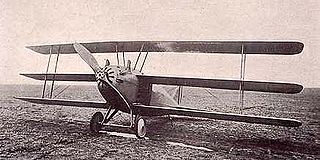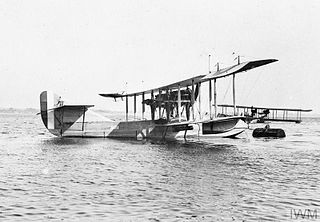Related Research Articles

The Naval Aircraft Factory (NAF) was established by the United States Navy in 1918 in Philadelphia, Pennsylvania. It was created to help solve aircraft supply issues which faced the Navy Department upon the entry of the U.S. into World War I. The US Army’s requirements for an enormous quantity of airplanes created a decided lack of interest among aircraft manufacturers in the Navy's requirements for a comparatively small quantity of aircraft. The Navy Department concluded that it was necessary to build a Navy-owned aircraft factory in order to assure a part of its aircraft supply; to obtain cost data for the department’s guidance in its dealings with private manufacturers; and to have under its own control a factory capable of producing experimental designs.

The Martin P5M Marlin, built by the Glenn L. Martin Company of Middle River, Maryland, was a twin piston-engined flying boat that entered service in 1951, and served into the late 1960s with the United States Navy performing naval patrols. It also served with the United States Coast Guard and the French Navy. 285 were produced.

The Convair R3Y Tradewind was an American 1950s turboprop-powered flying boat designed and built by Convair.

The Curtiss NC was a flying boat built by Curtiss Aeroplane and Motor Company and used by the United States Navy from 1918 through the early 1920s. Ten of these aircraft were built, the most famous of which is the NC-4, the first airplane to make a transatlantic flight. The NC-4 is preserved in the National Museum of Naval Aviation, at NAS Pensacola, Florida.

The Boeing XPBB-1 Sea Ranger was a prototype twin-engined flying boat patrol bomber built for the United States Navy. The order for this aircraft was canceled, to free production capacity to build the Boeing B-29, and only a single prototype was completed.

The McDonnell XP-67 "Bat" or "Moonbat" was a prototype for a twin-engine, long-range, single-seat interceptor aircraft for the United States Army Air Forces. Although the design was conceptually advanced, it was beset by numerous problems and never approached its anticipated level of performance. The project was cancelled after the sole completed prototype was destroyed by an engine fire.
Boeing XB-55 was a proposed Boeing aircraft designed to be a strategic bomber. The XB-55 was intended to be a replacement for the Boeing B-47 Stratojet in United States Air Force (USAF) service.

The Hall XPTBH was a prototype American twin-engined seaplane, submitted to the United States Navy by the Hall Aluminum Aircraft Corporation in response to a 1934 specification for new bomber and scout aircraft. Constructed in an innovative fashion that made extensive use of aluminum, the XPTBH proved successful in flight testing, but failed to win favor with the U.S. Navy. No production contract was awarded, and the single aircraft built served in experimental duties before its destruction in a hurricane during 1938.

The twin-engine F5L was one of the Felixstowe F series of flying boats developed by John Cyril Porte at the Seaplane Experimental Station, Felixstowe, England, during the First World War for production in America.

The Curtiss 18T, unofficially known as the Wasp and by the United States Navy as the Kirkham, was an early American triplane fighter aircraft designed by Curtiss for the US Navy.
The Kawanishi H3K, also known as Navy Type 90-2 Flying Boat (九〇式二号飛行艇), was a Japanese biplane military flying boat from the interwar period. The H3K was a development of the Short S.8/8 Rangoon. The first of the H3Ks was built by Short Brothers and the remaining four by Kawanishi in Japan.

The Curtiss Models F made up a family of early flying boats developed in the United States in the years leading up to World War I. Widely produced, Model Fs saw service with the United States Navy under the designations C-2 through C-5, later reclassified to AB-2 through AB-5. Several examples were exported to Russia, and the type was built under license in Italy.

The Curtiss Model H was a family of classes of early long-range flying boats, the first two of which were developed directly on commission in the United States in response to the £10,000 prize challenge issued in 1913 by the London newspaper, the Daily Mail, for the first non-stop aerial crossing of the Atlantic. As the first aircraft having transatlantic range and cargo-carrying capacity, it became the grandfather development leading to early international commercial air travel, and by extension, to the modern world of commercial aviation. The last widely produced class, the Model H-12, was retrospectively designated Model 6 by Curtiss' company in the 1930s, and various classes have variants with suffixed letters indicating differences.

The Norman Thompson N.T.4 was a twin-engined British flying boat of the First World War. Although less well known than similar Curtiss and Felixstowe flying boats, 50 were ordered for Britain's Royal Naval Air Service.
The Naval Aircraft Factory TF was an American twin-engine flying-boat escort fighter first flown in October 1920. The aircraft originated from requirements drafted by the British Technical Committee in April 1918, after discussion approved the development of a long-range seaborne fighter capable of escorting Allied maritime reconnaissance sorties over the North Sea and Atlantic regions.

The Curtiss HS was a single-engined patrol flying boat built for the United States Navy during World War I. Large numbers were built from 1917 to 1919, with the type being used to carry out anti-submarine patrols from bases in France from June 1918. It remained in use with the US Navy until 1928, and was also widely used as a civil passenger and utility aircraft.

The Hall XP2H-1 was an American prototype four-engined biplane flying boat of the 1930s. Intended as an experimental very-long-range maritime patrol aircraft, a single example was built. The XP2H-1 was the largest four engine biplane aircraft ever procured by the US Navy.

The Curtiss C-1 Canada was a twin-engined bomber aircraft of the First World War which was designed by Curtiss of America to be built by their Canadian subsidiary for the British Royal Naval Air Service and Royal Flying Corps. Although large orders were placed, only twelve were built, the type being rejected in favour of more capable aircraft such as the Handley Page O/100.

The Wanamaker Triplane or Curtiss Model T, retroactively renamed Curtiss Model 3 was a large experimental four-engined triplane patrol flying boat of World War I. It was the first four-engined aircraft built in the United States. Only a single example (No.3073) was completed. At the time, the Triplane was the largest seaplane in the world.

The Naval Aircraft Factory N-1 or Davis Gun Carrier was a 1918 maritime patrol aircraft built by the Naval Aircraft Factory (NAF), the in-house aircraft production arm of the United States Navy. A floatplane of biplane configuration with a single Liberty L-12 engine driving a pusher propeller, it was the first aircraft to be both designed and built by the NAF, and was designed to carry the Davis gun, the first recoilless gun. The first prototype crashed during its maiden flight due to poorly designed floats but was rebuilt. However, the aircraft's performance did not meet expectations, and navy leaders canceled the program after 2 of the 4 prototypes were subsequently damaged in serious crashes.
References
- 1 2 Trimble 1990, p. 53.
- ↑ Trimble 1990, p. 54.
- ↑ Trimble 1990, pp. 49-50.
- ↑ Trimble 1990, p. 52.
- 1 2 3 Trimble 1990, p. 335.
- ↑ Baugher, Joe (24 October 2017). "US Navy and US Marine Corps BuNos, First Series (A6002 to 9999)". joebaugher.com. Retrieved 30 May 2019.
- ↑ Trimble 1990, pp. 52-53.
- ↑ Trimble 1990, pp. 51-53.
- ↑ Trimble 1990, p. 50.
- ↑ Trimble 1990, p. 51.
- ↑ Trimble 1990, pp. 50-52.